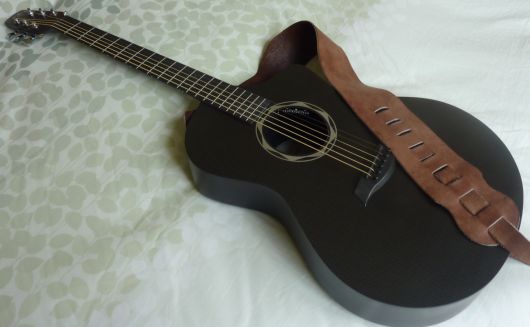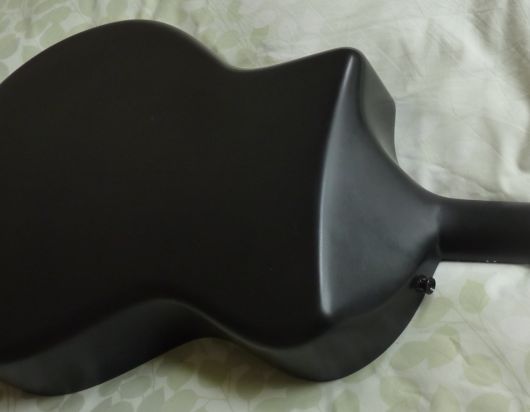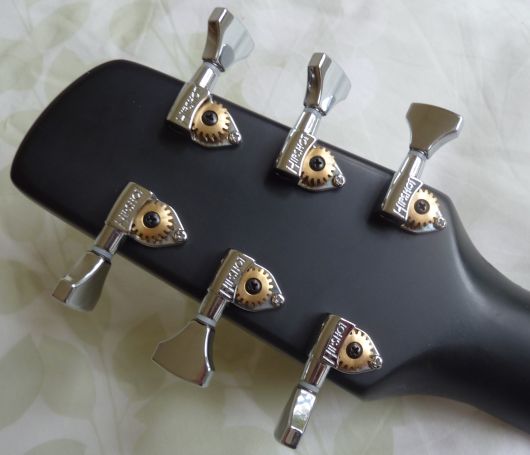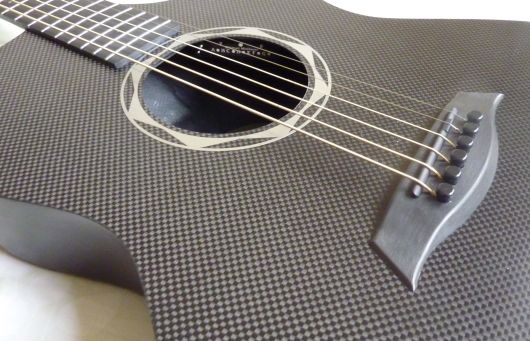Composite Acoustics OX Raw
Traveling to and from Hawai`i involves big changes in humidity, and this is a recipe for trouble with an acoustic guitar. I’ve suffered from rising action and even finish cracks from the wood swelling when I travel to the islands. Friends who have brought instruments from Hawai`i to California have experienced just the opposite – buzzing low action and a real risk of seam separations, braces coming loose, and even cracks in the top and back.
For a number of years builders have worked on more stable replacements for the wood in our guitars, and now we have plywood, aluminum, and a range of composites including fiberglass, kevlar, and carbon fiber. In fact one of the pioneers in carbon fiber guitars, Rainsong, started their business in Hawai`i and attracted a number of local players to their instruments.
Composite Acoustics is a relatively young company that started with a dreadnaught and bluegrass focus, but thanks to my encouragement (hey, I wrote them an email) they’ve developed some very fingerstyle friendly models, especially the new OX body style.
I’ve been very curious about the Composite Acoustics OX since I saw the first pictures, and when I found a used one offered in one of the guitar forums I visit, I snapped it up. Here’s my new baby in all its carbon fiber glory:

An old leather strap holds up the high tech carbon fiber OX.
The body on this beauty is pretty slick, so the soft old leather strap helps hold it in position. Note the perfectly smooth and comfortable (if graceless) merging of the neck, body, and cutaway:

The neck flows smoothly into the body
I like the simple detailing on this very reasonably priced guitar. The tuning pegs are some I’ve never seen before but they work nicely. I would prefer a bit lighter peghead, but that’s true of almost every guitar I try:

The tuners are attractive and work very well
The black woven look of carbon fiber is so hip now that you can buy fake carbon fiber decorative parts for your car or motorcycle. The drama is evident in this shot of the top of the OX. This is the simplest, least expensive finish offered by CA, they call it Raw. The bridge, saddle, and bridge pins are all fabricated from composites. The sound hole decoration is a thin sheet of brushed aluminum that floats above the weave. You can catch a glimpse of the Wittman Mini tuner peeking out of the soundhole. I’ve installed these in almost every guitar I own:

Dramatic weave of carbon fiber, a Wittman Mini tuner in the soundhole
I was hoping for a lot when I bought this guitar, and I’m not disappointed. I think Composite Acoustics has figured out a bunch of stuff very well to create the OX Raw. Here’s a bit of video, an old hula song called Papalina Lahilahi showing some of the fun of playing this lovely instrument:
The guitar is tuned to taropatch F, open G tuned down one whole step. From low to high: C F C F A C. The sound on this video was recorded on the Zoom H2, you can see the top of it just edging into the bottom of the shot. I pulled the audio file into Adobe Audition and tweaked the EQ just a bit, but there’s no reverb, compression or other effects, you’re hearing the sound of the guitar.
The only bad thing about finding a nifty new item like the OX is the sudden urge to explore other Composite Acoustics instruments, like that cute little Cargo travel guitar …
This entry was posted on Sunday, December 13th, 2009 at 4:59 pm and is filed under Guitar. You can follow any responses to this entry through the RSS 2.0 feed. You can leave a response, or trackback from your own site.
Matt Hayden said in post # 1,
on December 13th, 2009 at 10:22 pm
Fran – very nice. It’s got a very sweet sound.
And of course your playing gets every ounce of tone out of it.
That’s for posting this.
John Chamberlain said in post # 2,
on December 14th, 2009 at 4:29 am
Fran,
Ahhhh, another lovely tune…
Welcome, congrats on becoming a carbonista!
I have had two CA cargos, one in the Road Tuff finish and my current one, a Cargo in the Raw!
Love the Raw finish. Looks and tone abound…
Appreciate your sharing your talent.
JC
John Chamberlain said in post # 3,
on February 12th, 2010 at 8:16 am
Hey, Fran!
Would you happen to have the tab for Papalina Lahilahi? If so, please send to me…TIA.
John
Fran Guidry said in post # 4,
on February 12th, 2010 at 10:26 am
Hi, John,
Sorry, no tab. I was just humming the song to myself as I played it and making up stuff to go along with the melody.
Fran
Walt said in post # 5,
on February 24th, 2010 at 10:05 pm
Very nice playing. Just home with a new OX E glossy. Sounds so close to my Martin OM-28 is scary. No more worries about 10% humidity to 55% the next month. Not sure whats next. Cargo or Legacy. From the sounds of some of your friends this is going to be a whole new venture. Aloha
éjaculation à l'intérieur dépravée said in post # 6,
on July 19th, 2014 at 5:49 am
Vous publiez constamment des posts attractifs